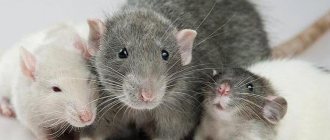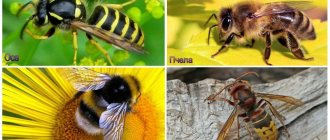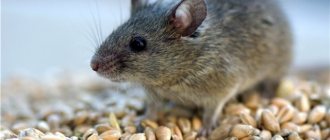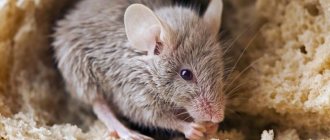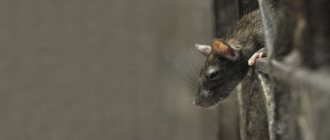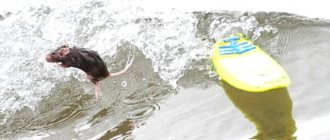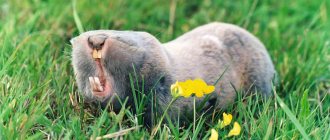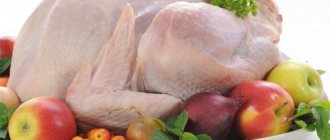There is practically not a single person who has not encountered mice or their cousins, rats, at least once in their life. Night rattles and rustling that prevent you from falling asleep, spoiled food, chewed furniture - all this indicates the appearance of unexpected guests in your home.
Some tirelessly fight with them, showing who is boss, while others, on the contrary, deliberately bring them into their homes, taming them and making them their favorites.
However, one should not ignore the fact that both mice and rats are the source of all sorts of dangerous diseases . Therefore, it is imperative to fight them. In order to choose the right method for getting rid of rodents, you need to know what their differences are.
And if in adults the difference is obvious - rats are much larger than mice, then what little rats and mice look like remains a question for many of us.
THE SMALLEST MOUSE
The little mouse is the smallest rodent in the world, and together with the pygmy shrew and the tiny shrew, it is the smallest mammal on the planet. The body length of this mouse is only 11-13 cm, and almost half of it is a long tail. The weight of an adult male is no more than 16 g, a newborn mouse is slightly less than 1 g. The flat muzzle with short ears, together with the bright reddish fur of the back and sides of the body, distinguishes the baby mouse well from other small rodents.
Along river valleys, this species penetrates far to the north - to the Polar Urals and Yakutia, and in the Central Caucasus it lives in alpine and subalpine meadows at an altitude of up to 2200 m. The little mouse lives primarily in wet meadows near rivers, along the edges of forests, and sometimes settles in fields, rice paddies and hayfields. It is extremely difficult to see and observe her. And the point is not only in its small size, but also in the amazing ability of this animal to hide and hide its presence. More often, a baby mouse is seen by chance, having scared it away from the nest, or in winter, when the animals gather in groups.
How is it different from a mouse?
Newborn rodents of different species are often confused with each other. The little ones are very similar to each other, but there are still many differences between them. An attentive person will quickly determine by the appearance of the babies exactly whose nest he was lucky enough to discover.
Rat cubs from mice are distinguished according to the following criteria:
- Size. The body of a newborn baby rat will be longer than that of a mouse.
- Muzzle. In a baby rat, it seems to be chopped off and has bulging eyes covered with skin.
- Ears. In the vole they are round and large.
- Tail. Mice have a long and thin tail. It is equal to the length of their body.
The baby rats in the photo will be larger in size. They are slightly thicker and darker than a newborn vole.
NEST ON STILTS
In summer, the baby mouse builds a spherical nest from blades of grass, slightly larger than a tennis ball, securing it between the long stems of plants. As a result, such a ball hangs above the ground at a height of up to 130 cm, although sometimes it can be located on the ground. The outer layer of the nest consists of woven large parts of plants, which are most numerous in the meadow, while the inner lining consists of smaller and softer materials. Such a dwelling is intended primarily for breeding offspring. From May to October, a baby mouse has 2 to 3 litters, consisting of 5-8, or even 12 pups. In England, for example, where climatic conditions are milder, animals breed even in December. At the same time, a separate nest is built for each litter, which helps mice avoid annoying parasites.
The nest does not have a special entrance, and the female, each time she climbs into it, makes the passage again. When leaving the nest, she always closes the hole. In this way, she improves camouflage and reduces the risk that some predator will discover her offspring. At the same time, on the territory of the mouse pair there may be one or more more simply arranged residential ball-houses, which the parents use for relaxation and shelter.
Mice develop very quickly and reach sexual maturity by about 40 days of age, and if conditions are favorable, they themselves have offspring in the same year.
How long after birth can you pick up
Seeing small newborn lumps swarming around an adult female, you just want to pick them up or at least touch them. Under no circumstances should this be done. Firstly, their body is still very fragile and the slightest wrong movement or compression can lead to injury to the baby. Secondly, after you hold the baby in your hand, its coat will acquire a specific human smell. Mother rats often abandon such babies: they stop taking care of them, don’t feed them, and don’t keep them warm. The result is inevitable death. Despite all the caring behavior of females towards their offspring, they can kill a baby that emits an alien odor.
You will be interested to know what to do if decorative rats fight among themselves.
By three weeks, babies already look strong enough and can eat “adult” food. Even if the female does not want to accept a cub that smells like a human, it will be able to live and feed on its own. Experienced rat breeders recommend not delaying the taming of decorative rats. When the animal is a month old, it needs to be taken as often as possible, then the baby will be more obedient and affectionate.
FIGHTING ANIMAL
The baby mouse is active all day, every three hours a short sleep and feeding alternate each other. The animals are very sensitive to overheating and try to avoid direct sunlight, so in summer they are usually nocturnal, while in winter they are more active during the day. To avoid enemies, the little mouse moves slowly and carefully, often freezing behind the stem of a plant. If danger persists, a wary rodent may even plummet downwards, hiding in the shadows on the ground.
The baby mouse feeds on all available seeds and fruits, and in the fall it sometimes makes small reserves of grain, which will come in handy in the coldest weather. After all, animals do not hibernate during the winter. In search of food, they scour under the snow, but not far from their “winter apartment.” This is simply a constructed hole or a ground shelter - among dead wood, under stacks and haystacks. If the winter is very harsh, the animals move into human buildings.
In the cold season, males and females live separately, uniting in pairs only to breed offspring, but in the most favorable places for wintering, for example, in stacks or granaries, they form clusters of up to 5 thousand individuals.
Younger age
Starting from the fourth day, the development of little rat pups occurs at a rapid pace.
- 4th day the ears open, the pups begin to distinguish sounds and hear rustling sounds;
- 6th body is covered with soft dark fluff;
- On the 8th, teeth emerge, except for the main incisors.
After 10 days of life, the pups become active. They crawl well and master the terrain. If these are pets, they should be handled more often so that the animals grow up tame. However, during the game they should not be left unattended, since coordination of movements is not yet developed, the kids can fall to the floor from a table, any height.
A SHORT, HAZARDOUS LIFE
In nature, the lifespan of baby mice is very short - up to a maximum of 1.5 years, but usually no more than 6 months. According to European scientists, 95% of all animals in the population die in winter. The main causes of mortality are cold or wet weather, sudden frosts and predators such as weasels, stoats, foxes, cats, owls and crows. Moreover, in captivity, animals can live up to 5 years. Peaks in the baby mouse population usually occur every 3 years, after which there is a gradual decline followed by growth. In nature, populations of this rodent are characterized by an extremely high reproduction rate, but at the same time very low survival rate. The baby mouse in some European countries is classified as a species that requires protection due to the gradual decline in their numbers. As the main threats to this species, researchers note the increasing intensification of agriculture and, as a result, the destruction of potential habitats, as well as the generally poor knowledge of the ecology of this species.
Reproduction
Baby mice breed three to four times a year and, on average, give birth to five to six cubs at a time, but there are cases where a female gave birth to eleven children at once. Newborn babies weigh less than one gram and are born blind, deaf and bald. But already on the eighth day they begin to see clearly, and at the age of two months they become completely independent and ready to reproduce. If the reproduction process occurs at home, then during this period it is better to transplant them into another cage, since the mother begins to prepare for the next birth, and the already adult cubs will bring her significant discomfort.
LITTLE MOUSE IN THE FOOD CHAIN
The main food of the baby mouse is the seeds of various herbs, primarily cereals and legumes, tree fruits and grains of cultivated plants. In summer, animals also readily eat small insects such as butterflies, moths and grasshoppers, and their larvae.
NUTRITION OF THE BABY MOUSE
CHINA MEADOW
In the second half of June, in sparse mixed and birch forests, on forest edges and slopes, and in steppe meadows, the herbaceous perennial blooms - meadow chin. On tall, up to 1 m, thin stems, among many small leaves and tendrils, clusters of bright yellow moth flowers light up. Soon they will turn into beans. This plant from the legume family is loved by sheep, horses, and geese. Nina meadow, like many other legumes, is very nutritious: it contains a lot of ascorbic acid, carotene and vitamin P, and microelements. And, despite the bitter taste, the little mouse gladly includes it in its diet.
OATS
The baby mouse's obligatory dish is grains of cultivated cereals. For example, oats. The fruits of this plant are distinguished by the optimal percentage of carbohydrates, proteins, fats and B complex vitamins. Oats contain the protein necessary for the body to grow and repair tissues. Soluble fiber lowers blood cholesterol levels, protecting the cardiovascular system. Vitamins and minerals are involved in important metabolic processes in the body. It is no coincidence that people use oats as a dietary product and include them in the diet of those recovering. The mouse, although it does not know about the chemical composition of the cereal, appreciates it, perhaps, more than a person.
ENEMIES OF LITTLE MICE
LASKA
This smallest representative of mustelids is a formidable enemy for the tiny mouse. Agile and agile, the weasel runs quickly and crawls through the narrowest cracks and holes. This bloodthirsty animal sometimes stores up to 30 voles and mice in reserve! There is no escape for small rodents either on the surface or in the burrow from this predator. She makes several holes in bird eggs and sucks out the contents. 6 In search of food, the hardy animal runs up to 2 km per day. The weasel moves skillfully under the snow and swims well. This animal is distinguished by its courage. Thus, the weasel desperately defends its nest, no matter how great the danger. Sometimes a weasel even copes with a bird of prey that attacks it itself, gnawing its throat in flight.
COMMON FOX
Mice and voles make up about three-quarters of this predator's diet. There is even a special term for fox hunting for small rodents - mouse hunting. The fox's ability to change its diet depending on its habitat is amazing. In the southern regions of Europe it eats reptiles, in the Far East, near rivers, salmon fish, and near the seashore, sea debris (from mollusks to large mammals). In the taiga it attacks large birds and even young ungulates. She deftly grabs beetles flying by, and after the rain she collects earthworms. Be sure to add fruits and berries to meat foods. But the hare becomes prey only during the period of lack of food; the fox very rarely chases after it.
GRAY OWL
This is one of the most common owls in temperate latitudes. She prefers to forage in forest clearings, forest edges and floodplain habitats, primarily at twilight and at night. The main food of owls is small mammals, which the owl detects with the help of exceptionally sensitive hearing. Moreover, in absolute darkness, the error when throwing for prey is no more than one degree.
How to care for baby rats
The total growth period for a rat is one year. During this time, the animal reaches the size of an adult: males weigh up to 600 g, and females - about 300 g. However, the foundation for full development is laid at a very early age. The cage with the female and newborn rats should be placed in the quietest and warmest room, where no one will disturb the family.
Don't worry about cleaning the nest - the mother rat will do it herself. You only need to periodically place new dry wipes in the cage, and the rat itself will throw dirty bedding into the corner. Only when the baby is 8–10 days old can you intervene in the cleaning process, carefully removing the waste material. This is only permissible if the female does not worry too much. Otherwise, cleaning should be postponed.
What do little rats eat?
The growth and development of cubs is largely influenced by the quality of nutrition. While staying near the mother for the first month, the basis of the diet is her milk. In order for it to be as beneficial as possible for babies, it is important to organize a balanced diet for the mother: in addition to the main food, the daily diet must include fruits, herbs, and animal food. Be sure to make sure that the female has enough water to drink - wash the drinking bowl and change the water daily.
Sometimes it happens that the female dies during childbirth, and if you cannot find her replacement (another nursing mother of a rat or mouse), you will have to do this yourself. Feeding newborn rat pups is not easy. For this purpose, dry infant soy formula, which is diluted with goat's milk, is best suited. Alternatively, you can use a pet milk replacer. Food is given to babies through a syringe. For convenience, you can equip it with a fabric pacifier.
Important! Little rats should not be given tomatoes, cucumbers and champignons, as well as any sweets.
In the first week you need to prepare the mixture as liquid as possible. Feedings are carried out every 2 hours during the day and a couple more times at night. In the second week, you can add ground grain feed to the mixture. Feeding periods are shortened - food is served every 4 hours. At week 3, the grain feed is simply mixed into the mixture and poured into a bowl. The cubs are already quite capable of eating it on their own.
By the end of the first month, a sufficient amount of protein should be present in the diet of rat pups, since a lack of this substance often leads to illness and mortality. The most useful additives: cottage cheese, boiled fish, apples, boiled chicken wings, egg yolks. Young rodents eat a lot: on average, their daily portion of grain is 80–100% of the weight of the animal itself.
INTERESTING FACTS
In nature, during years of high numbers, the baby mouse can harm grain crops. In addition, it is a natural carrier of pathogens of various diseases: tick-borne encephalitis, tularemia, leptospirosis, etc.
Unlike many other mice, this animal is very convenient and pleasant to keep at home. The excretions of these mice have almost no specific odor. The animals are a little shy, are easily tamed and are not picky about food, and observing their behavior can bring a lot of joy and vivid impressions to an attentive naturalist.
Habitat
This rodent can take root almost anywhere: in a field, in a meadow, in a forest. The only criterion for the area inhabited by baby mice is the abundance of grass, and it is desirable that it be tall. In it, a mouse can build a nest and feed itself. The nests of these animals are spherical and look like a real work of art. The little ones love to climb the stems of plants, which is not particularly difficult for them, because they weigh very little, and they also have a very tenacious tail.
Denis's seahorse
Denis's seahorse (lat. Hippocampus denise) is another little one and a master of camouflage. It lives in the warm waters of the western Pacific Ocean at a depth of about 16-90 m.
flickr/pats0n
One can only wonder how such a tiny creature, whose length does not exceed 1 cm, manages to survive among the cruel world of marine life. But it turns out that it is possible to survive: it perfectly camouflages itself as gorgonians or the corals in which they live, painting its body orange or yellow.
Fish Paedocypris progenetica
The smallest aquatic animal. The fish Paedocypris progenetica is recognized as the smallest inhabitant of water bodies. It can be found in sewage streams and peat swamps in Indonesia.
The largest are the females of these fish, but they are also small - 10.3 mm in length. The smallest officially recorded length of this fish is 7.9 mm. Interestingly, these little ones belong to one of the large carp families!
Microfrogs Paedophryne
The smallest land animal. Microfrogs (lat. Paedophryne) - this small frog belongs to the family of narrow-mouthed frogs, or microfrogs.
flickr/Yvonne Laurence
It is considered the smallest in the world, its length does not exceed 7.7 mm, but sometimes it grows up to 11.3 mm. This little one was recently discovered, it was found in Papua New Guinea. The females of these amphibians are slightly larger than the males. Thanks to its brown color, this frog is invisible neither on the ground, nor among the foliage, nor on tree trunks.
Snake Tetracheilostoma carlae
The snake Tetracheilostoma carlae is the shortest snake found in the Caribbean.
Blair Hedges, Pennsylvania State University
This baby grows to only 100-104 mm in length and can easily be confused with an earthworm. Likes to hide under stones and also in the soil. It feeds on termites, ant eggs and other small insects. Not poisonous.
In order to survive, many creatures during evolution have to take on the most bizarre shapes and unusual sizes. The most striking proof that nature has prepared many surprises for us are the miniature animals of our planet.
hummingbird bee
The smallest bird. The bee hummingbird (lat. Mellisuga helenae) is the smallest among birds.
flickr/dermoidhome
It was discovered in 1844 in Cuba by Juan Cristobal. Its weight is only 1.6-2 g, and its body length is 5-7 cm. It feeds, like all hummingbirds, on the nectar of flowers. Interestingly, the heart of this miniature bird beats at a frequency of 300-500 beats per minute.
Intelligence
The mental abilities of these two representatives of the mouse family are also very different. According to scientists, rats are intellectually developed creatures.
- Firstly, they will not settle in places that are potentially dangerous for them.
- Secondly, they always examine the future home and assess the situation.
- Thirdly, they create entire communities with their own hierarchy and laws.
Norushki are more reckless in this regard, and therefore it is much easier to fight them, since you can easily deceive or outwit.
